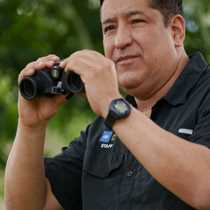Amazon Natural Park & Nauta Caño
We started our second full day of our expedition on the enigmatic and amazingly bio-diverse Amazon after breakfast exploring the Amazon Natural Park. We had two choices: a long walk or a shorter version. In both cases we had the joy to spot several plant species and listen to our expert Delfin II naturalists explaining some fascinating aspects of the ecology of the rain forest of the Neotropics.
The long walkers went farther along the trail had the thrill of crossing a suspension bridge. This state-of-the-art piece of engineering is approximately a half-mile in length. It allowed us to have a thrilling and exciting walk in the middle strata of the rain forest. We were above the ground watching the rain forest from a completely different perspective and feeling in some way how the inhabitants of the rain forest see the world in a dimension that is completely new for us.
One of the highlights of this morning was the spotting of one of the most beautiful and spectacularly colored frog species found in the Amazon, the Red-backed Poison Frog (Dendrobates reticulatus). This tiny frog is very small; it is less than an inch in length! We have to use our photographic skills to shoot a macro photo by putting our cameras very close to the animal. This frog species was found by the eagle eyes of our natural history staff and a couple of native scouts who accompanied us today.
The latter frog species is one of the most eagerly sought by visitors for it is not only beautiful but has a remarkable natural history as well. These frogs have alkaloid skin secretions that give them their common name. Traditionally many indigenous people use these powerful toxins all over the Amazon region to coat hunting darts and arrows. The toxicity of the secretions is determined by the frogs´ diet that consists mainly on some species of ants that they prefer to eat. The chosen ants contain high concentrations of formic acid. In captive conditions when these frogs are fed with other kind of insects they lose the toxicity.
In the afternoon, after lunch, we had an introductory about Amazon photography with our photo instructor Walter Perez. While listening to the talk we had the surreal thrill to hear dozens if not hundreds of parakeets who were frolicking around the place our ship was tied—by the way on rivers ships do not use anchors. The wonderful musical natural background was perfect company to the talk.
After the talk we explored Nauta Caño by skiff riding or by kayaking. We truly enjoyed this outing. This narrow stream is covered with thick vegetation where our naturalists spotted several species of colorful birds from the skiffs like macaws and toucans as well as a couple of monkey troops. Ten of our guests paddled quietly along in our comfortable double river kayaks; they poked under the riverside vegetation and explored just as much as the locals will do in their dugout canoes. For them, as I was told later, it was a thrill to be seeing the flooded forest with such intimacy creating an amazing experience.
Finally, late in the evening, after dinner we had a short walk, this time at night. We were immersed in the forest night sounds in total darkness. After this experience, we went to bed with many unforgettable feelings and memories in our hearts and minds of this full day of our expedition in the Peruvian Upper Amazon onboard the Delfin II.




